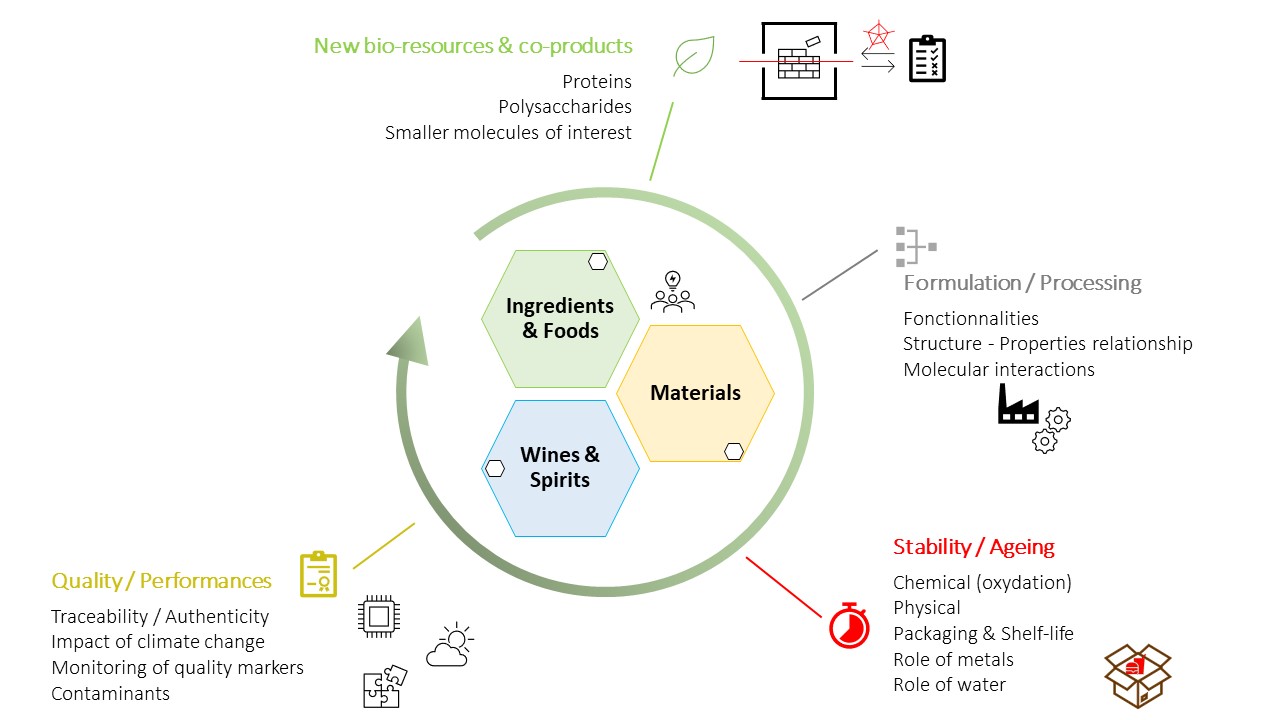Research topics
The PCAV team groups together chemists and physical chemists who work on ingredients and foods, wines and spirits, and materials in contact with or from foods/wines. The team is developing expertise in 4 main areas related to food and wine matrices:
- Valorisation of new bio-resources and co-products
- Formulation and processing
- Stability - Shelf-life
- Evaluation of performances and qualities
The PCAV team implements integrated approaches to study systems from the macroscopic to the molecular scale. In addition, these 4 themes are envisaged as a scientific continuum from the raw material to the formulation and stability of products, with a real territorial anchoring, as well as a very strong interaction with industry, in a societal context of environmental concern and climate change.
Scientific questions

The search for animal protein-alternatives and the preservation of their functionalities is a major challenge for new food design.
Some molecules are currently under-valued: proteins from fishing or oil industry waste, proteins from microalgae, proteins from insects...
To establish this expertise and give it an innovative dimension, the team has set up a combination of strategies, which on one hand integrates "clean label" approaches, and on the other collaborations with new scientific partners.
Other molecules from agro-resources, such as polysaccharides or smaller molecules of interest, can also be used in the food or cosmetic industries, or even in the form of coatings or integrated into food packaging.
For example, the VALVIGNE project (2020-2022) aims to enhance the value of co-products of the wine industry such as pomace to extract oligopeptides and oligosaccharides, which can have applications in oenology (new antioxidants) or viticulture (new elicitors). Within the framework of this project, the team developed new green extraction processes based on supercritical CO2, subcritical water and microwaves, in order to reduce the environmental impact of the extraction methods.
The valorization of natural resources is based on 3 aspects: the efficiency of extraction methods, the degree of isolation and the preservation of native structures. However, it is often necessary to functionalize these molecules which sometimes have a weak technological aptitude initially. These targeted functionalities are: rapid solubilization in water; capacity to emulsify, to swell or to gel; film-forming aptitude; aptitude for aroma retention or even catalytic aptitude (for example enzymatic).
The study of the impact of processes on technological capabilities cannot be limited to an analysis of capacity gains. It is also necessary to understand the consequence of a process on the conformation of the macromolecule, or on the structure of the matrix (food or film) at the end of the process. For this purpose, the PCAV team has developed an expertise in tools and methods of structure characterization at different scales (infrared spectroscopies, Raman, low field NMR, circular dichroism, neutron scattering). This can vary from the molecular scale (secondary structure of a protein or a peptide) to the microstructural scale.
In the field of oenology, this theme has become the identity of the PCAV team. We have become a leader in the study of the oxidative stability of white wines thanks to a unique integrated methodological approach. This approach covers the chemistry of wine up to the physical chemistry of oenological stoppers. It provides decision-making tools to the wine industry, allowing a "personalized oenology" to reduce additives during the wine-making process, and ultimately to be able to choose the process and the stopper best-suited to letting the wine age best.
The development of non-targeted analyses, such as metabolomics applied to wine (the most exhaustive analysis possible of all the metabolites of a biochemical system), offers a systemic approach integrating viticulture and oenology. This approach is based on the hypothesis that the instantaneous composition of a wine is the result of multiparametric processes at work from the vine to the bottle.
In addition, the study of oxidation mechanisms, governing the stability of foodstuffs, remains a major challenge in order to better protect the products. The role of metals is particularly important, as iron, for example, acts as a catalyst of oxidation reactions. New assay methodologies need to be developed.
The work of the PCAV team on product stability also targets the protection conferred by the packaging. High oxygen-barrier, active (antioxidant) and intelligent packaging are all being developed. A smart system capable of providing information on the state of oxidation of the packaged product has even recently given rise to a patent.
Finally, this theme addresses the issue of the physical stability of food matrices. This is based on the study of fundamental concepts such as the role of water and environmental parameters on the physical and chemical stability of polymers.
The question of performance and quality evaluation constitutes a gateway to scientific themes related to food and wine. The previous research is considered in relation to environmental concerns and/or societal expectations.
The design of targeted analytical methods, based on the synthesis of molecular imprinted polymers or specific molecular probes, opens up original applications in the development of intelligent materials. There is also the potential for improved performance monitoring by detecting marker molecules or active compounds in trace amounts. Future research includes detection of contaminants in food or recycled materials, allergens, or fraud detection.
Global quality evaluation, which now represents a strong competence developed within the PCAV team, is also oriented towards the determination of the "typicity" of products. First applied to wine, it has also been extended to other products with geographical authentication needs. For example, the CASSIS Project (“Blackcurrant”) groups the producers of the sector in Burgundy.
Environmental concerns related to climate change have led the PCAV team to develop an innovative approach to the concept of quality of agri-food matrices. Metabolomic, climatological and oenological data are examined as one. The metabolic response of some grape varieties submitted to a wide range of global climatic conditions, will allow the metabolic future of the corresponding wines to be anticipated under different climatic trajectories.






